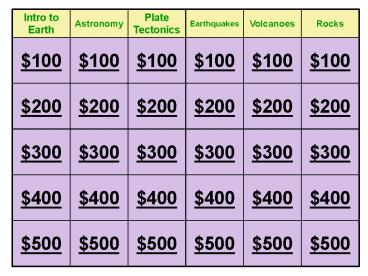Intro - PowerPoint PPT Presentation
Title:
Intro
Description:
Intro to Earth Astronomy Plate Tectonics Earthquakes Volcanoes Rocks $100 $100 $100 $100 $100 $100 $200 $200 $200 $200 $200 $200 $300 $300 $300 $300 $300 $300 $400 $400 – PowerPoint PPT presentation
Number of Views:133
Avg rating:3.0/5.0
Title: Intro
1
Intro to Earth Astronomy Plate Tectonics Earthquakes Volcanoes Rocks
100 100 100 100 100 100
200 200 200 200 200 200
300 300 300 300 300 300
400 400 400 400 400 400
500 500 500 500 500 500
2
Intro Maps for 100
Name the four branches of Earth Science.
3
Intro Maps for 100
- Geology
- Astronomy
- Oceanography
- Meteorology
4
What is the name of our galaxy?
5
The Milky Way galaxy
6
Alfred Wegener is credited with the idea of
???????
7
Continental Drift
8
What is the difference between a fracture and a
fault?
9
A fracture is just a crack in the ground, but a
fault is when there is movement along the
fracture.
10
What are the three main types of volcanoes?
11
1. Shield Volcano2. Cinder Cone Volcano3.
Composite Volcano (aka stratovolcano)
12
What determines whether a rock is igneous,
sedimentary or metamorphic?
13
The way that it is formed.
14
Which metric unit would be appropriate to give
the distance from Cary to Greensboro?
15
kilometers
16
Which scientist invented the telescope?
17
Galileo
18
Earths many lithospheric plates float on the
?????
19
asthenosphere
20
Where is the foot wall of a fault located?
21
BELOW the fault
22
Mt. St. Helens is an example of which type of
volcano?
23
Composite Cone
24
What are the two types of igneous rocks?
25
Intrusive Extrusive
26
What process do scientists use to solve problems?
27
Scientific Method
28
Our sun is in what phase of its life cycle?
29
Main Sequence Star
30
What is the action at a divergent boundary? AND
Give an example of where this type boundary is
found.
31
Plates are pulling apart.Ex. mid-ocean ridges
32
What does the hanging wall do in a reverse fault?
33
The hanging wall moves UP.
34
Name describe three types of mafic lava.
35
Pahoehoe wrinkled, ropey Aa sharp, jagged
chunksPillow Lava globs of lava that are
extruded underwater
36
What determines the difference between the
clastic sedimentary rocks?
37
Size of the particlesex. Large
conglomerateMedium sandstoneSmall shale
38
Which branch of earth science studies meteors
that streak across the sky?
39
Astronomy
40
Explain the differences between a meteor, a
meteorite, and a meteoroid.
41
Meteoroid located in spaceMeteor has entered
Earths atmosphereMeteorite has crash-landed
onto Earth
42
What features are formed at a oceanic-to-oceanic
convergent boundary AND where could you see such
a boundary?
43
Trench and a volcanic island arcex. Aleutian
Islands andJapanese Islands
44
Name the three major earthquake zones?
45
1. Mid-Ocean Ridges2. Pacific Ring of Fire3.
Eurasian-Melanesian Belt
46
Which types of tephra can be carried by the
global winds and distributed worldwide?
47
Volcanic dust and ash
48
What are the two ways that metamorphic rocks can
be formed?
49
Regional metamorphismContact metamorphism
50
A student wants to determine which color absorbs
heat the most. The experiment has many different
colors of paper under a lamp and the temperature
of each is recorded.Name the Independent
Variable.Name the Dependent Variable.
51
Independent Variabledifferent colorsDependent
Variabletemperature
52
Name and explain the theory about how our
universe began.
53
The Big Bang Theory states that all the matter of
our universe began in one tiny point. There was
some type of explosion and all that matter and
energy was flung outward and created our
expanding universe.
54
Name the three types of plate boundaries and give
the type of stress associated with each.
55
1. Divergent Boundary stress2. Convergent
Boundary compression3. Transform Boundary --
shearing
56
Name at least three ways that earthquakes might
be predicted.
57
1. The ground tilting2. Small foreshocks3.
Seismic gap theory
58
Explain the difference between a crater and a
caldera.
59
A crater is a funnel-shaped pit at the top of the
volcano. A caldera is a bowl-shaped depression
created when the walls of the crater collapse.
60
What is the difference between a foliated and
nonfoliated metamorphic rock?
61
Foliated has a striped (or banded)
appearance.Nonfoliated does not have stripes
(or bands).














![⚡[PDF]✔ Public & Private Families Intro PowerPoint PPT Presentation](https://s3.amazonaws.com/images.powershow.com/10047346.th0.jpg?_=20240604104)
















